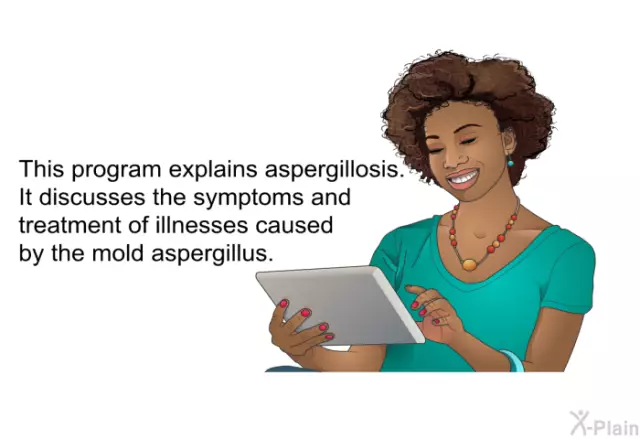- Author Rachel Wainwright [email protected].
- Public 2023-12-15 07:39.
- Last modified 2025-11-02 20:14.
Aspergillosis

Aspergillosis refers to an infectious disease of the skin, lungs, paranasal sinuses and other internal organs caused by Aspergillus molds. These fungi enter the human body when spores are inhaled. Of particular concern is the fact that they are widespread in nature and are found not only in soil, flour or cereals, but also simply in dusty rooms. Cases have been recorded when certain forms of aspergillosis (for example, pulmonary aspergillosis) affected people even in a hospital setting. The cause of aspergillosis is still the same - dust and insufficiently responsible attitude to cleaning the premises.
In some cases, the symptoms of aspergillosis appear as an endogenous infection, but this is rather an exception to the rule and is true only in relation to people with weakened immunity. In recent years, the problem of infection with aspergillosis in individuals with various immunodeficiencies has become quite acute. Suffice it to say that pulmonary aspergillosis is detected in 20% of patients diagnosed with HIV. Initially, aspergillosis affects the lungs, then the pleura and lymph nodes. Through the blood vessels, aspergillosis spreads to other organs. Very often, pulmonary aspergillosis turns into generalized (septic), which in 50% of cases leads to the death of the patient. Note that the disease is not transmitted from person to person.
Aspergillosis symptoms
The length of the incubation period has not been precisely established, however, it is known that pulmonary aspergillosis can affect any organs and tissues. Doctors distinguish several forms of aspergillosis, depending on where the pathogens are located.
Aspergillosis of the lungs - Aspergillus is deposited on the surface layers of the mucous membrane of the bronchi and in the lungs. As the infection develops, more and more new body systems are involved in the process. Patients have:
- general weakness;
- cough with gray sputum;
- increased body temperature;
- chills;
- shortness of breath, chest pain;
- lack of appetite;
- bad dream.
In addition to the aforementioned symptoms of aspergillosis, patients taste moldy in their mouths. Sometimes greenish lumps are found in the sputum, which are an accumulation of fungi. Note also that the chronic form of aspergillosis is usually secondary. This means that in the diagnosis of chronic aspergillosis, treatment primarily involves the search for the primary disease, the clinical symptoms of which are often superimposed on the secondary infection. The probability of death in this form of the disease ranges from 20 to 37%.
Septic aspergillosis - symptoms manifest themselves against the background of a sharp suppression of immunity. Patients have: lesions of the gastrointestinal tract, moldy breath, liquid foamy stools, red nodules on the skin, brain abscesses. Against the background of opportunistic infections and a suppressed immune system, aspergillosis often leads to the death of the patient (in at least 50% of cases).
Aspergillosis of ENT organs - occurs after operations on the inner ear or past diseases of the larynx and nasal mucosa. Aspergillosis is common among people who work in weaving and malt factories. The symptoms of this form of aspergillosis are similar to those of otitis externa and otitis media.
Aspergillosis treatment

Regardless of the type of infection, treating aspergillosis is a laborious task. Chemotherapy and antibacterial agents do not lead to the expected effect, as, indeed, all other methods of combating infectious diseases known to doctors. For this reason, in recent years, when diagnosing aspergillosis, treatment has been based on the use of surgical methods. Patients undergo lobectomy with resection of the affected organs. If the operation was performed by a competent specialist in compliance with all established procedures, the intervention is tolerated without complications and gives good predictions for the future. With advanced forms of pulmonary aspergillosis, surgical treatment is used in conjunction with conservative methods. Patients with aspergillosis are prescribed amphotericin B, oxacillin, nystatin, erythromycin, tetracycline antibiotics. At the same time, a person takes vitamins. General strengthening treatment is also recommended for patients with aspergillosis.
When using antimycotic drugs, the amount of antibodies in the blood increases sharply, but by the end of treatment it returns to normal. If pulmonary aspergillosis leads to lesions of the skin and mucous membranes, antimycotic and anti-inflammatory drugs are recommended for patients.
As for the prognosis of treatment. Aspergillosis of the lungs is fatal in 20-35% of cases (in HIV-infected patients the mortality rate reaches 50%). When mucous membranes and ENT organs are infected, the prognosis is usually favorable. In the septic form of aspergillosis - unfavorable. It is very important to identify the symptoms of the disease in time and make the correct diagnosis, therefore, the earlier the patient turns to the doctor with complaints about the worsening of his condition, the higher the chance that the treatment will save the person's life.
YouTube video related to the article:
The information is generalized and provided for informational purposes only. At the first sign of illness, see your doctor. Self-medication is hazardous to health!






